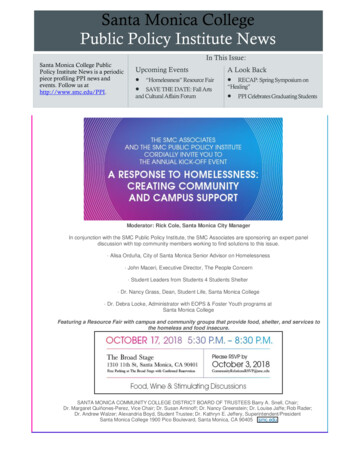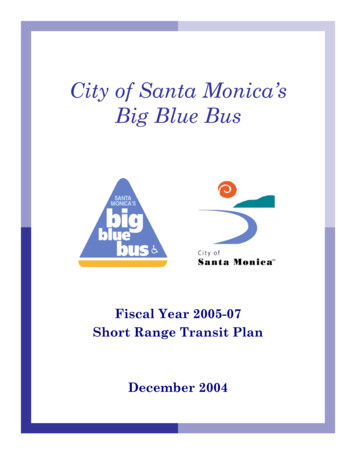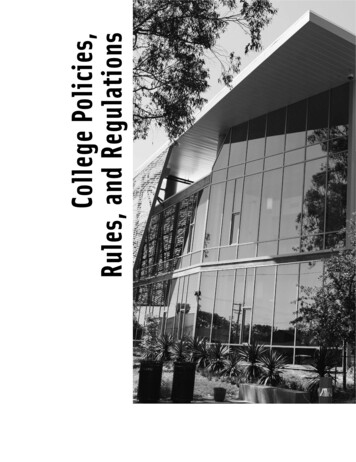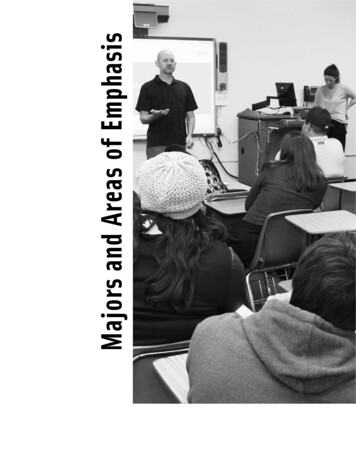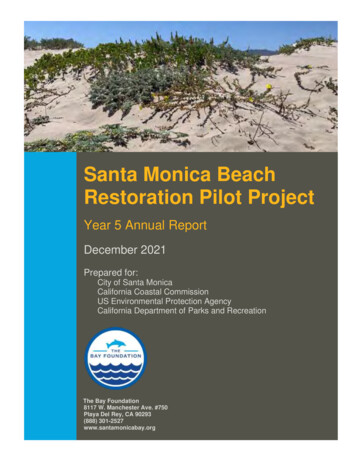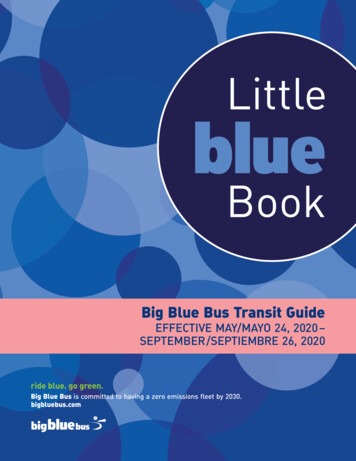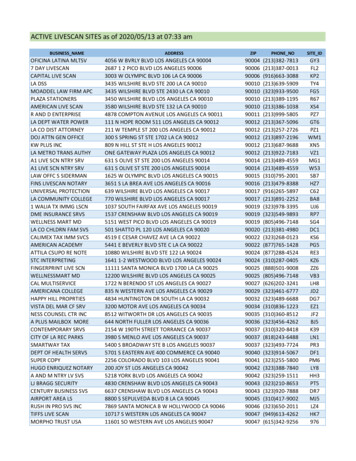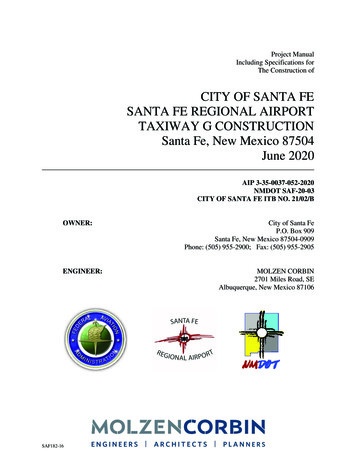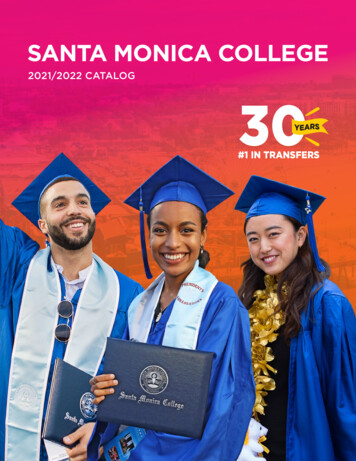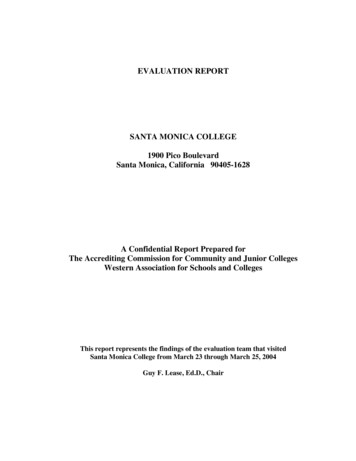
Transcription
EVALUATION REPORTSANTA MONICA COLLEGE1900 Pico BoulevardSanta Monica, California 90405-1628A Confidential Report Prepared forThe Accrediting Commission for Community and Junior CollegesWestern Association for Schools and CollegesThis report represents the findings of the evaluation team that visitedSanta Monica College from March 23 through March 25, 2004Guy F. Lease, Ed.D., Chair
SANTA MONICA COMMUNITY COLLEGE DISTRICTComprehensive Evaluation Visiting TeamMarch 22-25, 2004Dr. Guy F. Lease (CHAIRPERSON)Superintendent-PresidentLake Tahoe Community CollegeDr. Michele NelsonTrusteePalomar Community College DistrictMr. James AustinVice Chancellor – Business ServicesGrossmont-Cuyamaca CCDDr. Janet PortolanVice President, Educational Support andPlanningFullerton CollegeMs. Carmen GuerreroProfessor, BusinessOxnard CollegeDr. Diane Scott-SummersVice President, Student ServicesDiablo Valley CollegeDr. Audre LevyPresidentLos Angeles Southwest CollegeDr. Patricia SpencerSuperintendent/PresidentVictor Valley CollegeDr. Lori Gaskin (Team Assistant)Vice President, Academic Affairs andStudent ServicesLake Tahoe Community CollegeMs. Maria SugranesDirector, Library ServicesSanta Ana CollegeMs. Gail LevyAssociate ProfessorLeeward Community CollegeDr. Frederick TrappAdministrative DeanLong Beach City College-2-
ACCREDITATION EVALUATION REPORT FORSANTA MONICA COLLEGEComprehensive Evaluation VisitMarch 23-March 25, 2004Committee Chair: Guy F. LeaseSummaryOn March 22-25, 2004, a 12-member evaluation team visited Santa Monica College tovalidate the college’s 2004 Institutional Self-Study for Reaffirmation of Accreditation anddetermine a recommendation to the Accrediting Commission for Community and JuniorColleges for the Western Association of Schools and Colleges. The team arrived on theafternoon of March 22, 2004, for a team orientation meeting and to begin the in-depth reviewof the college’s self study report.The team found that all previous recommendations of the 1998 visiting team were addressedin the self study. During the visit the 2004 team developed several of its ownrecommendations as well as a number of commendations. None of these recommendationsare classified in the “non-compliance” category, despite the seriousness with which the teambelieves these issues are to the future of the college.Santa Monica College is a large, urban comprehensive single-college district serving adiverse student population that peaked in 2002/2003 with almost 34,000 students. Thecollege is located on a very compact 40-acre campus in the middle of the city and has fivesatellite campuses nearby. In 1988 Santa Monica College opened its first satellite campus inthe former Douglas Museum and Library complex at the Santa Monica Airport. Two yearslater the second satellite campus opened at the former Madison Elementary School site. In1998 the college opened its prestigious Academy of Entertainment and Technology at stillanother satellite location.More recently, in 2001 the college moved some of its operational services to a newlyacquired office building a few blocks from the main campus. This provided additionalstudent services space on the main campus for the instructional services department andrelieved a distinctly overcrowded administrative services area. In 2002, the college acquiredtwo additional properties. The college purchased a four-story downtown office building toserve as the permanent home for Emeritus College, a highly popular program for seniors thatopened in the fall of 2003. In addition, the college acquired the Bundy site at the SantaMonica Airport that is scheduled to open for classes in the fall of 2004 or spring 2005.The college recently completed an 80 million modernization program including a newscience complex, a reconfigured business building, and a 20 million expansion of thecollege library. In March 2002, the college successfully passed a 160 million safety and-3-
modernization bond issue to upgrade and enhance facilities. There are bold plans for futurecapital improvements on the main campus and the Bundy site that will allow the college torecover completely from the devastating effects of the 1994 Northridge earthquake and tomeet the growing needs for instructional, student services, and support space for the college.The college experienced a 35 percent increase in student enrollment between 1997-98 and2002/2003. However, as a result of the state’s financial crisis and the subsequent mid-yearrevenue cuts proposed for the California community colleges by Governor Davis inDecember 2002 coupled with the even larger cuts the governor proposed for the 2003-2004state budget, the Board of Trustees took action in the spring of 2003 to address the potentialfinancial crisis. Course offerings for fall 2003 were reduced by 27 percent and this reductioncarried over to the 2004 spring semester. Several academic programs were discontinued,full-time tenured faculty were laid off or retired early, classified employees were also laid offor vacancies were not replaced, and a number of student services were reduced. Enrollmentin the 2003-2004 academic year is down by approximately 7,000 students compared to 20022003. Some of these actions resulted in discord between members of the various constituentgroups on campus and the administration, and in a perception that the college’s decisionmaking processes are not reflective of the collegewide planning process.Almost a full year after these reductions were made the team found a college stillexperiencing deep-seated resentment and tension among the various constituent groups.There is a clear interest in having the administration convene a collegewide representativegroup to develop and implement concrete strategies and governance processes to improvecommunication and professional relationships. The team strongly urges the administration toinitiate such an activity in order to create a campus climate characterized by collegiality andmutual respect for the long-term benefit of the institution’s ability to serve its stated mission.Despite the reductions that have already been made, the college faces a lingering financialcrisis that must be addressed in the 2004-2005 fiscal year. With such a significant loss offull-time equivalent students in 2003-2004, the college must recover these enrollments orface catastrophic revenue reductions next year. The college has a recovery plan in place andthe team found a campus aware of the plan and prepared to implement it with greatconfidence that it will be successful.The college engages in a number of activities that directly relate to the identification ofstudent learning outcomes. Institutional research plays an important role in the planningefforts of the college and in the assessment of its effectiveness in providing qualityeducational programs and services. However, the college’s dialogue has not yet reached thestage of defining, explicitly stating, and assessing student learning outcomes at the course,program, and degree/certificate levels. This dialogue must begin in earnest in the near futurein order for the campus to gather the data necessary to continue to improve its instructionaland student services programs.The college faces many significant challenges in the near and mid-term future. Despite thesechallenges, the team found members of the board, faculty, staff, administrators and studentswho take great pride in the instructional and student services programs of the college and in-4-
the ongoing success of student achievement factors such as transfers, graduation rates, andother student success measures. It is the hope of the team that these recommendations willserve to assist the college in focusing its efforts on institutional improvement and the longterm best interests of its students, faculty, staff, and the communities the college serves.-5-
IntroductionOn March 23-25, 2004, an evaluation team of 12 members visited Santa Monica College inaccordance with the policies and procedures established by the Accrediting Commission forCommunity and Junior Colleges of the Western Association of Schools and Colleges. Inadvance of the visit, the team reviewed the institutional self study, the college’s catalog andother supporting documents, and the report of the previous team. Each member was asked towrite a preliminary review of the standards to which he or she was assigned. For two andone-half days the team held on-campus meetings with individuals and groups; conductedinterviews of administrators, faculty, support staff, and students; examined files, reports, anddocuments; observed classes and facilities; and attended on-campus meetings. In total theteam had almost 300 faculty and staff contacts, visited classes on all the college’s sites, andtalked with students across the campus. In addition, the team held two open sessions thatwere attended by a large number of the college community.Santa Monica College, originally known as “Santa Monica Junior College,” opened its doorsin 1929 with 153 students. By fall 2002 enrollment exceeded 34,000 students; however, justone year later, due to California’s state budget crisis, enrollment in the fall of 2003 haddropped to approximately 27,000.The college, which began by holding classes in Santa Monica High School, is now located ona 40-acre campus at 1900 Pico Boulevard, and has five satellite campuses.Since it first opened, Santa Monica College has been headquartered at three locations.Classes were moved from the high school to an old elementary school building across thestreet. When a 1933 earthquake rendered that building unsafe, classes were held in a villageof wooden-framed tents affectionately nicknamed “Splinterville.” Finally, the college movedto its present site in stages beginning in 1948.Although the main campus houses the majority of its students and programs, the limitationsof a 40-acre campus has forced the college to look to off campus locations to accommodateongoing as well as emerging programs.In 1988, Santa Monica College opened its first satellite campus at the Santa Monica Airportand two years later, the second satellite campus opened at the former Madison ElementarySchool site. In February 1998 the college opened its prestigious Academy of Entertainmentand Technology at a third off-campus location.In 2002, the college acquired two additional properties. Planning for the development of a10.4-acre site near the Santa Monica Airport at Centinela and Airport Avenue is currentlyunderway, with occupancy of the first building scheduled for fall 2004 or spring 2005. Thecollege also purchased a four-story office building at 1227 Second Street to serve as thepermanent home for Emeritus College, a highly popular program for seniors. EmeritusCollege moved to the new building in fall 2003.-6-
The 1994 Northridge earthquake, which damaged multiple buildings on the main campus anddestroyed others, served as a catalyst for several building projects and improvements to thecampus. The college recently completed an 80 million modernization program, including anew 35 million science complex (replacing a building destroyed in the earthquake) whichopened in fall 1999, a 20 million expansion of the Santa Monica College library which reopened in fall 2003, new computers and telecommunications networking, and a completelyreconfigured business building. These projects were made possible by Proposition T, a bondmeasure approved by local Santa Monica and Malibu residents, and earthquake restorationand other funds from the federal and state governments.In March 2002, Santa Monica passed Measure U, a 160 million safety and modernizationbond issue to upgrade and enhance its facilities. The funds will be put to a variety of usesincluding technology improvements at the main and satellite campuses, renovation of SantaMonica College’s Main Stage Theater to meet modern teaching standards, a new StudentServices & Administration Center, replacement of the Liberal Arts Building, andconstruction of a new addition to the Science Complex for nursing, environmental sciences,earth sciences, math, and related programs.Today Santa Monica College is the west side’s leading job trainer and the nation’sundisputed leader in transfers to the University of California system, including to UCLA.Additionally, Santa Monica College’s reputation for quality attracts students from more than105 countries around the world, and currently more international students choose SantaMonica College to begin their higher education than almost any other community college inAmerica. The tuition international students pay helps support Santa Monica College in itsefforts to recruit and retain an outstanding faculty and support staff.Over the past six years the college has experienced both unusual growth and suddencontraction. Between 1998 and 2002, college enrollment increased by 35 percent and thecollege increased its full-time faculty and its classified staff accordingly. However, due tothe very serious state budget crisis that threatened to significantly reduce funding to theCalifornia community colleges in December 2002 and January 2003, the college initiated amajor contraction in the spring of 2003. Courses for that semester were reduced by 7.5percent and for the fall 2003 semester by 27 percent. Enrollment dropped from a high near34,000 in the fall of 2002 to near 27,000 in the fall of 2003. To address budget concerns forthe 2003-2004 academic year, the college also discontinued several academic programs,offered retirement incentives, terminated the employment of classified staff, and significantlyreduced services. Disagreements over the processes used for the discontinuance of programsand the budget development overall significantly impacted the process and timing of the selfstudy as well as dominated the discussions the team held on campus during the visit. Theteam found many various, often conflicting, perspectives on controversial issues.Since the previous accreditation team’s visit the college has experienced a major setback inits attempts to establish and maintain adequate reserves to ensure the stability of the college.The college ended the 2002-2003 fiscal year with undesignated reserves below one percentand during the 2003-2004 fiscal year found itself once again on the chancellor’s “watch list.”The college has an enrollment recovery plan and, if it is successful, in 2004-2005 the college-7-
will be able to restore its reserves, many of the programs and services that have beenreduced, and the financial security it needs to effectively serve its large and diverse studentbody. There is a plan for further reducing the college’s expenditures if enrollment does notreturn and surpass 34,000 students in the coming year.The self study report was developed with the participation of faculty, staff, administrative,and student representatives, although many participants elected to withdraw from the study inthe midst of its development in protest to the budget decisions made in 2003. Although thegoverning board was not directly involved in the development of the self study, the boardclosely followed the self study process and received drafts prior to the final adoption of theself study in January 2004. Due to problems with membership on the standard committees,the final report was completed later than scheduled and resulted in a final edit beingcompleted primarily by the vice president of academic affairs (co-chair of the study) over thesemester break. Campus constituents were given only a few days to review the finaldocument but subsequently had the option of providing additional comments in writing to thevisiting team prior to its arrival. The Academic Senate elected to submit comments upon thearrival of the team. This letter and many other comments during the visit indicated therewere some on campus who disagreed with the final editing and the resulting tone of thereport.Despite several serious problems identified by the team, and in the self study itself, the teamfound a highly dedicated faculty, administration, and staff, and an exceptionally wellsatisfied student body. It was truly inspirational to talk to student leaders who were universalin their appreciation for the instructional and student services the college provided to them.However, the team also found a college with deep-seated problems related to governance,communication, and trust. While there are many excellent governance and planningprocesses in place at Santa Monica College, there are problems with poor communicationbetween campus constituent groups, inadequate funding and a lack of adequate reserves,inaccurate and conflicting financial data, linking and evaluating planning processes andoutcomes, and a lack of focus on student learning outcomes. All of these were addressed inthe exit report to the campus and in the recommendations of the team.The team’s experience at Santa Monica College was both very positive and very negative.Friendly college staff provided invaluable logistical support and warm hospitality throughoutthe visit. There was a strong sense of pride among all college constituencies as well asgenuine concern for the success and welfare of students. Students expressed appreciation forthe quality of the education they were receiving. The negative encounters emanated from theconstant expression of pain constituent group leaders and administrators had experienced forseveral years, but particularly in the past year, as the college struggled to deal with the lackof state support and adequate resources to maintain the programs and services that hadpreviously existed.Despite the problems encountered, the evaluation team commends Santa Monica College forits dedication and commitment to providing a quality learning environment and studentsupport services. In particular, the team wishes to express the following overallcommendations:-8-
1. The college is to be commended for a very strong instructional program with a widerange of curriculum designed to meet the very diverse needs of its students. Theinstructional programs are characterized by ongoing attention to review and improvementrelated to student learning. The faculty’s dedication and commitment to teaching and itsfocus on the mission of the college, despite internal and external challenges, is to becommended as well.2. The program review process is well-defined, well-understood, valued, and valuable as ameans of ensuring ongoing, regular evaluation of programs for the purpose of dialogue,reflection, and improvement.3. The college is to be commended on the comprehensive and vibrant number of studentservices programs and the staffs of these programs who show an exceptionally strongcommitment to the success of the students.4. The college is to be commended on the variety of programs and projects designed toincrease retention, persistence, and success of targeted students including first-timestudents, black students, Latino students, female and reentry students, EOPS students,DSPS students, students involved in club and Associated Students activities andprobationary students to name a few. The college demonstrates a strong commitment tothe success of its students and the students feel that commitment.5. The college is to be commended for a transfer program that enables the college to transfermore students to the University of California than any community college in the UnitedStates. The commitment to transfer is a source of pride on this campus and is prevalentthroughout the college community.6. The college is to be commended for its support of student and club activities. Thecollege’s student activity hours provide a valuable opportunity for students to sharecultural, intellectual, academic, transfer, and governance information on a regular basis.7. The college is to be commended for its development of unique and diverse facilities thatare tailored to specific communities within the district, such as the Emeritus College forthe large and active senior community.8. The superintendent/president has a local, state, and national presence that has resulted inthe successful passage of two major bonds to rebuild the campus and expand it to allowthe college to meet its mission in the future. She has increased grant funding for thecollege and successfully advocated for equalization funding that will bring millions ofdollars to this campus. The team commends her efforts to rebuild the capacity of SantaMonica College to maintain its preeminent role in higher education.9. The college has an excellent data mart available to the campus from the research officeand effectively uses research and data in support of operational planning and action.-9-
To assist the college in ensuring continued success, the team identified seven majorrecommendations. None of the recommendations is considered in the “non-compliance”category as defined in the Commission standards. These recommendations are listed belowand individually at the end of the most appropriate standard.Recommendations1. The team recommends the college initiate an institutionwide dialogue about studentlearning outcomes and processes to facilitate learning. This dialogue should lead todocumented implementation and results of a cyclical process of learning outcomesdevelopment, systemic assessment, and institutional and programmatic improvement.2. To implement the college’s shared vision, the team recommends the college devise anintegrated multi-year planning cycle to include instructional and student servicesprograms, human resources, facilities, technology, and equipment. Annual budgets andresource development should be derived from this multi-year plan.3. The team encourages the college in the strongest terms possible to pursue strategies thatwill result in a financial system that will produce clear, reliable, timely, and transparentreports in which all constituents can have full faith and confidence.4. The team recommends the college consider establishing a reserve for contingencysufficient to maintain stability and meet financial emergencies and unforeseenoccurrences.5. To ensure the economic viability of the institution, the team recommends the collegemust focus on developing and implementing the enrollment recovery plan, whileconcurrently developing the specific contingency plans to address alternative enrollmentand economic scenarios.6. The team recommends the college clarify, develop, document and regularly evaluate theroles of individuals and constituent groups in college governance and decision-makingstructures and processes to ensure their effective participation and communicate theprocesses and outcomes to the college community as the basis for continuedimprovement.7. The team recommends that the college develop and implement concrete strategies andprocesses to improve communication and professional relationships in order to create acampus climate characterized by collegiality and mutual respect.-10-
Standard IInstitutional Mission and EffectivenessResponses to the Recommendations from the Previous TeamThere were no recommendations from the previous team that required a response in StandardI.I A. Mission StatementObservationsThe college has a statement of mission that defines the institution’s broad educationalpurposes, its intended student population, and its commitment to achieving student learning.Through interviews and minutes of meetings of the Collegewide Coordinating Council andthe Board of Trustees the team was able to validate that the college periodically revisits thevision, mission, and goals statements through a public and inclusive process. It was apparentthat the broad language mission statement is intended to guide the institutional planning anddecision-making processes.In 1995 the Board of Trustees for Santa Monica College adopted new vision, mission, andgoals statements that identify objectives that define the institution, form the foundation forinstitutional planning and direct the college’s future development. It is the policy of thecollege to review and revise as appropriate the vision and mission statements at least everysix years. In 2002 the Collegewide Coordinating Council took the responsibility for thereview; and prior to adoption of the current statements, distributed a draft of the revisedstatements to all college constituencies represented on the Collegewide CoordinatingCouncil. This review was conducted under the college’s governance and decision-makingprocess. The Collegewide Coordinating Council adopted the revised statements in May 2002and the Board of Trustees adopted the statements at its regular meeting in August 2002. Allare published in the Santa Monica College Catalog each year and can be found on the collegewebsite. The college presents evidence of broad participation in the development of both ofits mission statements. (I A.1, 2, 3, and 4.)The mission statement focuses on creating a learning environment that meets the needs of itsdiverse student body and fostering an open exchange of ideas. As an outgrowth of the 2002revision of the mission statement, a focus group representing all college constituenciesdeveloped a series of planning issues to guide the creation of specific institutional objectives.This ultimately led to the approval of 35 specific institutional objectives that were approvedand included in the 2002-2003 update of the Master Plan for Education. The team noted thatthis Master Plan for Education is not a long-range master plan but more of annual planfocused on specific objectives for an academic year.The program review process has guidelines that specifically require that the departmentdiscuss how the goals and objectives of the college are integrated into the program. The-11-
Academic Senate Joint Information Services Committee uses the mission and goals as aguide for allocating resources to meet various departments’ technology needs.ConclusionsThe college meets the standards regarding mission and the use of a mission statement toguide planning and decision making. The college demonstrates a clear vision of itseducational mission and purpose. The team noted a consistent focus on the college vision of“Changing Lives Through Excellence in Education” by faculty, administration, classifiedstaff, and students. The mission statement and this vision are intended to be the cornerstonesof the Master Plan for Education.The mission statement has led to the development of six institutional goals and numerousobjectives that shape college policies and priorities as expressed in the Master Plan forEducation. There is evidence that the various collegewide governance and decision-makingbodies routinely consider these documents in the planning of academic and student servicesprograms. However, when college resources were threatened by the fiscal crisis in the Stateof California, there were those who questioned the effectiveness of this process. The January2003 announcement of the governor’s 2003-2004 budget and 2002-2003 mid-year fundingreductions resulted in the Board of Trustees discontinuing five vocational programs andsubsequently laying off three tenured faculty members while five others accepted earlyretirement incentives. This led to campuswide concerns as to whether the mission statementwas appropriately considered by the administration and Board of Trustees as the centralfocus in the decision-making process. The team interpreted the decision to discontinuevocational programs in 2003 was made to ensure the college had the capacity to remainfiscally solvent. In a letter to the president of the Academic Senate dated September 2, 2003,the Board of Trustees wrote, “Based on all data available, as well as careful review andunderstanding of both the short-range and long-range budget climate, the Board took the onlyaction possible to protect the interests of students and the quality of instruction at thiscollege.” There was also concern expressed that the administration and the Board ofTrustees were making important decisions without meaningful input from constituent groups.In its response, the Board replied, “Since early January, the Board of Trustees has beenactively involved with the college administration as well as the college constituency groupsand has received suggestions or recommendations on how to proceed through this budgetarycrisis. The actions taken by the Board are based on a careful evaluation of information andadvice.”It appears to the team that the college meets the standard but the necessity to discontinuethese programs created a distraction that created unfortunate friction throughout the campuscommunity and ultimately resulted in the expression of this distrust throughout theaccreditation review process.-12-
I B. Institutional EffectivenessObservationsThe college has identified the need for a systematic process to articulate and assess studentlearning outcomes and the teaching-learning process and then to use the assessment resultson student learning for improvement. While it appears that a dialogue has been occurring ona limited basis at the department- and program-level, there is no evidence of a collegewidecommitment to a planning cycle for student learning outcomes that would include an ongoingand systematic cycle of evaluation, integrated planning, resource allocation, implementation,and re-evaluation.To its credit, the college has engaged in some sporadic initiatives that have been launched toprobe student learning. The Specialized Curriculum Optimizing Retention in Education(SCORE) discussions by counseling, math and English faculty illustrate that interest. Thosediscussions were initially instigated by campus research but need to be extended to includethe continued systematic collection of direct evidence about student learning andachievement. There is a thorough discussion in Standard II of the self study about the effortsto address student learning and achievement.In so
SANTA MONICA COLLEGE 1900 Pico Boulevard Santa Monica, California 90405-1628 . Victor Valley College Dr. Lori Gaskin (Team Assistant) Vice President, Academic Affairs and . construction of a new addition to the Science Complex for nursing, environmental sciences, earth sciences, math, and related programs. .
